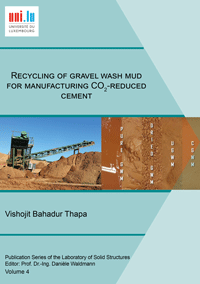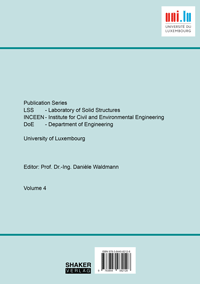
Shop : Details
Shop
Details
49,80 €ISBN 978-3-8440-8212-8Softcover308 pages70 figures529 g24 x 17 cmEnglishThesis
March 2022
Vishojit Bahadur Thapa
Recycling of gravel wash mud for manufacturing CO2-reduced cement
The present research project “CO2REDCEM” is carried out at the Laboratory of Solid Structures (LSS) of the University of Luxembourg, in close collaboration with Luxembourgish industrial partners (Cimalux S.A., Carrières Feidt S.A. and Contern S.A.). This project aims at reducing the generation of CO2 emissions during cement production by minimisation of the use of cement clinker or its complete replacement by new binder compositions and concepts, containing novel material resources derived from local unused industrial waste products. Such a potential raw material is gravel wash mud (GWM), which occurs as a waste product from gravel mining. This clayey mud is collected from a sludge reservoir, located in the North West of Luxembourg. Currently, this waste product is landfilled without any further use. However, this prime material offers very promising properties, which require a thorough characterisation and verification before its revalorisation as a viable supplementary cementitious material (SCMs).
Reusing or recycling of waste elements into goods has been among the greatest ambitions of our and earlier generations, and it will take a more important role in the future economy. One primary goal of this project is to replace the “end-of-life” concept of gravel wash mud by reusing it as new raw material. This endeavour will bring double benefit to environment as the waste is prevented from landfilling, and it is revalorised as a prime resource in another system.
This research work allowed to assess the performance of the waste product GWM as a valid pozzolanic prime material and to understand the requirements on physical, chemical and mineralogical characteristics of any potential raw material to ensure its permissibility as an alternative SCM.
Reusing or recycling of waste elements into goods has been among the greatest ambitions of our and earlier generations, and it will take a more important role in the future economy. One primary goal of this project is to replace the “end-of-life” concept of gravel wash mud by reusing it as new raw material. This endeavour will bring double benefit to environment as the waste is prevented from landfilling, and it is revalorised as a prime resource in another system.
This research work allowed to assess the performance of the waste product GWM as a valid pozzolanic prime material and to understand the requirements on physical, chemical and mineralogical characteristics of any potential raw material to ensure its permissibility as an alternative SCM.
Keywords: Gravel wash mud (GWM); Alternative clay materials; Calcined clays; Supplementary cementitious material (SCM); Pozzolanic activity; Illite; Kaolinite; Metakaolin; Lime; Alkali-activated binder; Blended cements; blended lime-clay pastes; Concrete
Schriftenreihe des Laboratory of Solid Structures
Edited by Prof. Dr.-Ing. Danièle Waldmann, Luxemburg
Export of bibliographic data
Shaker Verlag GmbH
Am Langen Graben 15a
52353 Düren
Germany
Am Langen Graben 15a
52353 Düren
Germany
Mon. - Thurs. 8:00 a.m. to 4:00 p.m.
Fri. 8:00 a.m. to 3:00 p.m.
Fri. 8:00 a.m. to 3:00 p.m.
Contact us. We will be happy to help you.



